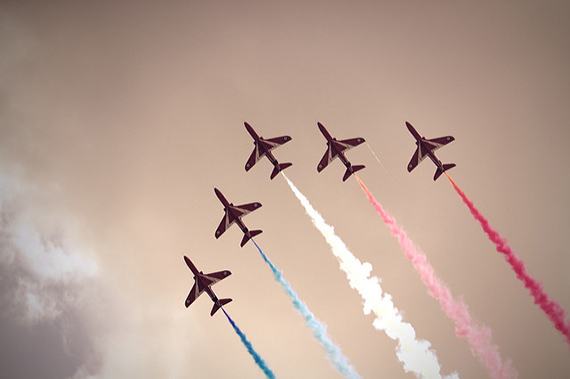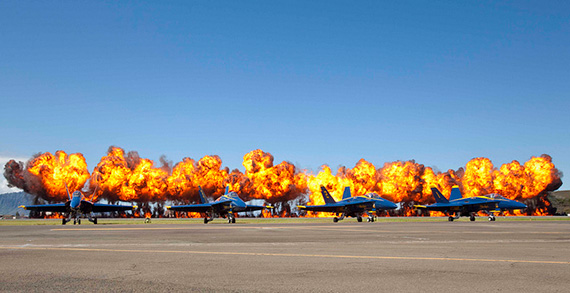Each summer, at air shows across the globe, awestruck spectators enjoy the power and precision of aerial demonstration teams and individual performers. In addition to what is happening in the air, there are often static displays on the ground. For photographers, these events provide outstanding photographic opportunities. After you shoot your first air show, you will likely return each year as I do. The tips below are based on my experiences at air shows around the New York area.

photo by Richard Jones
Day of the Show
It is recommended that you get to the show at least one hour in advance in order to find parking, and a shooting location. Air shows can be very crowded, with numbers reaching into the tens of thousands. By arriving early, you may be able to set your gear up in a prime area. Generally, the performers enter from the left and right, with their stunts done at “show center.”

photo by DVIDSHUB
A good viewing spot is important, as it allows you to focus and track the incoming jets. When possible, I try to pick a place that’s in the shade with a full view of the show center. However, many airports and military bases do not have trees to block the sun. To protect yourself from the elements, I strongly urge you to bring sunscreen.
Lens Choices
When I photographed my first air show many years ago, I used a 28–135mm lens. Yet, unless the plane was flying directly above me, I found that much more reach was necessary. Today, I use a 70–200mm for action that’s directly overhead, and a 400mm for tighter shooting. My camera does not have a full frame sensor, so a 400mm with a 1.6 crop factor is actually an effective 640mm lens. Just remember, air shows are usually several hours in duration, and longer lenses can get quite heavy.
photo by Tony Hisgett
Image stabilization is a nice feature, but a tripod will give your arms a break and allow you to create sharp images consistently. While the majority of my aviation work is shot with longer lenses, I find that wide angle lenses are also useful for performance teams that are spread out in wide formations. By utilizing a few different options, you can capture more of the action, and will come home with a diverse collection of images.
Shutter Speeds
Attempting to freeze the motion of something traveling over five hundred miles per hour is no easy feat. In order to achieve this, a fast shutter speed of around 1/1000 is recommended. Yet, like most aspects of photography, there are exceptions to this. With older planes, a shutter speed of 1/1000 will freeze the propellers. The effect actually reduces the appearance of motion, and gives the image an unnatural look.
To show the movement of the propeller, a shutter speed of 1/90 is a good starting point. However, you may have to adjust it slightly to 1/60 or slower, depending on the speed of the plane. Of course, with these slow shutter speeds you will want to pay close attention to your camera technique to ensure sharp images.
photo by Martin Pettitt
In-Camera Metering
Even today’s sophisticated DSLR metering systems can be tricked by certain situations. When exposing a jet against a clear blue summer sky, automatic camera settings will often properly expose the sky, and leave you with an underexposed plane. In order to have full control over the camera, I prefer to use the in-camera spot meter along with the manual exposure mode. Semi automatic modes can be effective as long as you are utilizing your histogram, and making adjustments as needed.
Most often, I find myself around 1/1000 of a second, ISO 400, and f/5.6. Of course, this can change drastically depending on the weather conditions of that particular day.
Focus
Rather than trying to frame the perfect shot, I like to use a high speed burst mode and fire off many frames for each pass. This technique increases the percentage of keepers. Following high speed objects this way takes some getting used to. Thankfully, most cameras feature continuous focusing, also known as AI Servo. This mode will allow you to continually focus on moving subjects. To use this feature successfully, keep your center focusing point over the aircraft with your cable release or shutter held halfway down.
As you follow the plane through your viewfinder, the camera will automatically adjust the focus as the aircraft gets closer. When you are ready to make an image, simply press the shutter all the way down. Luckily, air show organizers often arrange “photo passes,” where the pilot flies at a reduced speed. Don’t get too comfortable though, they return to full speed after just a few slow turns.
Memory
With all of this high flying, fast-paced action, you will likely go through many memory cards rapidly. I bring a portable hard drive with me, and download the contents of the card while continuing to shoot. Once I’m sure the images have been safely written to the drive, I format the card in camera and reuse it.
I like to shoot in RAW format whenever possible. However, if you are short on memory cards, and don’t have a portable hard drive, you may want to consider shooting in the Large/Fine JPEG format. This will allow you to f it more images on the card than RAW.
What to Look For
Smoke trails and after burner effects are great additions to an aviation image. Be ready for them, as they happen quickly. The trails of white smoke are actually created by pumping oil into the exhaust pipe. This is particularly interesting when used by an entire formation of planes.
photo by Andy L
The patterns of smoke can be used to make for a more artistic composition. In addition, it adds a bit of contrast to the otherwise plain blue sky. I also look to capture the interaction between two planes. When pilots are flying side by side with their wings nearly touching, a great deal of tension is introduced to the photo. By freezing this moment in time you are also showcasing the precision and skill of the daring pilots.
Enjoy the show!
About the Author:
Chris Corradino from Christography is a professional photographer based in New York City.
- - - - - - - - - - - - - - - - - - - - - - - - - - - - - - - - - - - - - - - - - - - - - - - - - - - - - - - - - - - - - - - - - - - - - - - - - -
Did you appreciate this newsletter? Please help us keep it going by Joining Our Patreon Supporters
What are your thoughts on this article? Join the discussion on our Facebook Page
PictureCorrect subscribers can also learn more today with our #1 bestseller: The Photography Tutorial eBook
Want to learn on-the-go? Throw these Snap Cards in Your Camera Bag
- - - - - - - - - - - - - - - - - - - - - - - - - - - - - - - - - - - - - - - - - - - - - - - - - - - - - - - - - - - - - - - - - - - - - - - - - -
The post How to Photograph an Airshow 🛩️ appeared first on PictureCorrect.
from PictureCorrect https://ift.tt/m1SApQ8
via IFTTT






0 kommenttia:
Lähetä kommentti